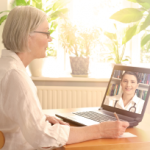“Ideally, medical care should be designed to provide necessary support for patients regardless of whether it is online or on site,” he says.
About 16,100 Japanese medical institutions excluding dentists—nearly 15% of all such facilities—offered remote medical services, including by telephone, as of early July, according to the health ministry.
That marks substantial growth since July 2018, when only 970 medical institutions were registered to offer online care.
Still, the health ministry has not decided whether to make the changes permanent, while the national medical association is less than enthusiastic, citing concerns about misdiagnosis.
“We should be extremely cautious about using evidence drawn from telemedicine in the emergency situation for consideration of how it should be after the coronavirus infection wanes,” Japan Medical Association President Toshio Nakagawa tells Reuters. He was vice-president at the time of the interview.
Analysts say telemedicine can also put smaller clinics at a financial disadvantage.
Goichiro Toyoda, representative director and a medical doctor at Medley, agrees doctors can better check first-time patients in person but says telemedicine suits patients who want second opinions, have trouble visiting hospitals or need long-term treatments.
“Telemedicine will not replace face-to-face treatment,” says Dr. Toyoda. “But I’ve been stressing the importance of it becoming an option.”



